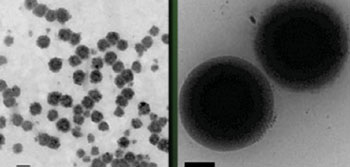Nanoparticles Deliver Viral Gene That Activates Toxic Drug Inside Brain Cancer Cells
By LabMedica International staff writers
Posted on 18 Feb 2015
Cancer researchers have described a nanoparticle-based gene therapy system that inserted the gene for the enzyme herpes simplex virus type I thymidine kinase (HSVtk) into brain tumor (glioma) cells and rendered them highly sensitive to the chemotherapeutic agent ganciclovir.Posted on 18 Feb 2015
Ganciclovir is a synthetic analogue of 2′-deoxy-guanosine. It is first phosphorylated to ganciclovir monophosphate by a viral kinase during infection. Subsequently, cellular kinases catalyze the formation of ganciclovir diphosphate and ganciclovir triphosphate, which is present in 10-fold greater concentrations in Cytomegalovirus (CMV) or herpes simplex virus (HSV)-infected cells than uninfected cells. Ganciclovir triphosphate is a competitive inhibitor of deoxyguanosine triphosphate (dGTP) incorporation into DNA and preferentially inhibits viral DNA polymerases more than cellular DNA polymerases. In addition, ganciclovir triphosphate serves as a poor substrate for chain elongation, thereby disrupting viral DNA synthesis by a second route. Use of ganciclovir for cancer treatment is restricted by a range of serious side effects. Common adverse drug reactions include: granulocytopenia, neutropenia, anemia, thrombocytopenia, fever, nausea, vomiting, dyspepsia, diarrhea, abdominal pain, raised liver enzymes, headache, confusion, hallucination, seizures, pain and phlebitis at injection site (due to high pH), sweating, rash, itch, increased serum creatinine and blood urea concentrations. Furthermore, ganciclovir is considered a potential human carcinogen, teratogen, and mutagen.

Image: Nanoparticles in low and high resolution micrographs (Photo courtesy of Green Laboratory, Johns Hopkins University).
Investigators at Johns Hopkins University (Baltimore, MD, USA) devised a way to use a less toxic pro-drug form of ganciclovir (GCV) that would become activated by HSVtk enzyme action localized inside the cancer cells. To transport the HSVtk gene to tumor cells they fabricated nanoparticles from HSVtk DNA combined with the poly(beta-amino ester) (PBAE) polymer, poly(1,4-butanediol diacrylate-co-4-amino-1-butanol) end-modified with 1-(3-aminopropyl)-4-methylpiperazine. The nanoparticles were 138 ± 4 nanometers in size and 13 ± 1 millivolts in zeta potential.
Results published in the February 2, 2015, online edition of the journal ACS Nano revealed that the HSVtk DNA-containing nanoparticles showed 100% cancer cell killing in vitro in two glioma cell lines when combined with GCV exposure, while control nanoparticles encoding an irrelevant gene maintained robust cell viability.
For in vivo evaluation, tumor-bearing rats were treated with PBAE/HSVtk infusion via convection-enhanced delivery (CED) in combination with systemic administration of GCV. Intracranial CED employed a pressure gradient to enhance diffusion throughout the tumor. Following a single CED infusion, labeled PBAE nanoparticles spread completely throughout the tumor, and the treated animals showed a significant benefit in survival.
"We evaluated the system in rats with glioma and found that by using a method called intracranial convection-enhanced delivery, our nanoparticles could penetrate completely throughout the tumor following a single injection," said senior author Dr. Jordan J. Green, associate professor of biomedical engineering and ophthalmology at Johns Hopkins University. "When combined with systemic administration of ganciclovir, rats with malignant glioma lived significantly longer than rats that did not receive this treatment. We will move forward by evaluating this technology in additional brain cancer animal models."
Related Links:
Johns Hopkins University














